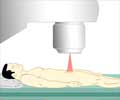Breihan Bridgewater suffering from emphysema sleeps on his side because he feels like there’s a boulder resting on his chest when he lays flat on his back.
The thought of undergoing surgery or having to lie on his back and undergo more than 40 radiation treatments left 74 year old Breihan with an uneasy feeling - and a decision to make when he was diagnosed with prostate cancer.The Lewisville resident decided he would not seek treatment for his early-stage prostate cancer.
After Mr. Bridgewater told his UT Southwestern Medical Center doctors that the decision was determined because he didn’t believe he could withstand the standard treatment for prostate cancer, they referred him to Dr. Robert Timmerman, vice chairman of radiation oncology.
Dr. Timmerman is leading a national clinical trial testing the effectiveness of stereotactic body radiation therapy (SBRT) to treat prostate cancer in five, 30-minute sessions.
The SBRT technique is a relatively new procedure used for treating localized tumors by delivering very high doses of focused radiation. Dr. Timmerman has successfully used the technique to treat patients with lung and liver cancers.
“There are a number of good treatments for prostate cancer, but they all have some drawbacks – they’re inconvenient; they’re invasive; or they cause impotence, rectal injury or urinary incontinence,” said Dr. Timmerman.
Advertisement
Prostatectomy, the surgical removal of the prostate gland, which can be done with minimally invasive techniques and robotic assistance;
Advertisement
“This new treatment mimics the dose deposition of brachytherapy, but it is done noninvasively, in an outpatient setting, without making any incisions, needle punctures or anesthesia,” Dr. Timmerman said. “The beauty of it is that the patient only has to come in for five outpatient treatments and is finished in a week and a half.”
Source-Eurekalert
JAY/C





![Prostate Specific Antigen [PSA] Prostate Specific Antigen [PSA]](https://www.medindia.net/images/common/patientinfo/120_100/prostate-specific-antigen.jpg)





